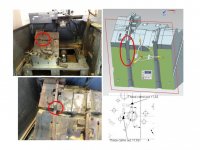Hi Mazo:
You need to break up your goals and address them separately.
First goal is to cut most of the material away, leaving you enough stock so everything cleans up to size when the job is finished.
So do a first roughing pass that's well undersized by adding to your roughing offset but using your regular roughing power settings.
I suggested adding another 0.1mm to your usual roughing offset, but if you're worried about it, you can add more to be safe.
Your next goal is to find out what the roughing pass actually made.
I do it by adding the same amount of extra offset to the first skim pass and going around the pocket, noting where it cut and where it didn't.
I use that information to judge whether I can safely take another roughing pass with reduced flushing and higher wire tension, or whether I should go straight to my skim passes.
The next goal is to get the stock left on the walls perfectly even.
If it will be skim passes, I leave my power settings correct for first skim passes, and start going all the way around the pocket over and over, each time reducing the offset by 20 microns or so, until the wire is cutting evenly all the way around the part walls.
My first few skims at this setting will leave some areas un-cut, and will start to cut in other areas.
So long as those un-cut areas are still smaller than the final pocket will be, all will clean up eventually.
Once it does, you can measure what you still have to remove and then set that amount in your offset to bring your pocket to the size you need for your finish skims.
Where you're probably misunderstanding, is that the errors you are seeing in your test cut come from the fact that the wire was deflecting from its intended path mostly because of the flushing pressure of your roughing cut.
As soon as you turn the flushing pressure off for your first skim, the wire will want to stay where the machine positions it and will cut away the bits that are too small while ignoring the bits that are larger than your current offset setting will reach.
By successively decreasing the offset and going round and round the pocket, you gradually erode the high spots away.
If you try to do it all in one skim, the wire will have too much to cut in some places and the skim cut will bog down.
Also I've found that taking too much with a skim cut leaves a belly in the surface which then requires more skim cuts to remove, so you want to avoid having skim cuts trying to remove too much material.
But you can just go around and around the pocket, knowing that the wire is cutting where the machine is telling it to, because the main deflecting force is now gone (your flushing pressure is off, or at least greatly reduced).
However; your normal offset settings, the ones that come with normal machine operation are no longer valid, so you have to keep track of what each offset is doing.
A good way to confirm this is true, is to make a test cut on a simple test piece.
Wire cut a round hole in the normal way on a flat piece with perfect sealed flushing, and measure what you get.
Now duplicate only the last skim cut without touching the offset and see how much the hole grows in size.
Run the last skim cut again and see the hole grow again.
You can often take out as much as 25 microns by repeating the skim cut over and over again without touching the offset, until the wire finally stops cutting and the hole size stops growing.
That's why it's normally not recommended to jigger with the offsets when you're cutting normal parts with normal flushing; the size of the finished part depends on always having the right amount of stock for the next skim cut.
But in your circumstances you MUST jigger the offsets in order to avoid overcutting the part from wire deflection, so now you need to sneak back to where the wire can cut evenly around the part and get the process back under control.
What I would do to give myself some confidence, is cut one of the openings a couple of millimeters too small and go through the whole process so you can see what happens without wrecking the part.
Once you're confident you can achieve control over the size, you can re-cut the pockets to finished size with more confidence.
You must always remember though, the high flushing pressure on an asymmetric parting line will make the first roughing cut completely unpredictable, so it's unwise to make a test cut, measure the result and then presume you can simply adjust the offset and go again; that only works on flat parts with good, sealed flushing.
Cheers
Marcus
Implant Mechanix – Design & Innovation - home
Vancouver Wire EDM -- Wire EDM Machining





